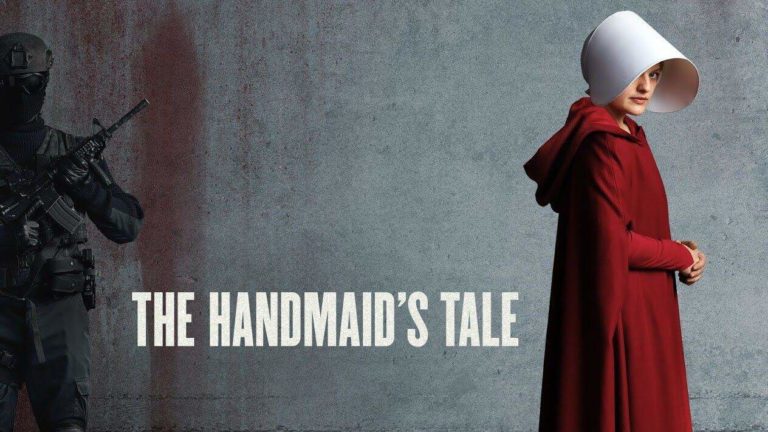A group of people is coming towards us. They’re tourists, from Japan it looks like, a trade delegation perhaps, on a tour of the historic landmarks or out for local colour. They’re diminutive and neatly turned out; each has his or her camera, his or her smile. They look around, bright-eyed, cocking their heads to one side like robins, their very cheerfulness aggressive, and I can’t help staring. It’s been a long time since I’ve seen skirts that short on women. The skirts reach just below the knee and the legs come out from beneath them, nearly naked in their thin stockings, blatant, the high-heeled shoes with their straps attached to the feet like delicate instruments of torture. The women teeter on their spiked feet as if on stilts, but off balance; their backs arch at the waist, thrusting the buttocks out. Their heads are uncovered and their hair too is exposed, in all its darkness and sexuality. They wear lipstick, red, outlining the damp cavities of their mouths, like scrawls on a washroom wall, of the time before.
I stop walking. Ofglen stops beside me and I know that she too cannot take her eyes off these women. We are fascinated, but also repelled. They seem undressed. It has taken so little time to change our minds, about things like this.
Then I think: I used to dress like that. That was freedom.
Westernized, they used to call it.
The Japanese tourists come towards us, twittering, and we turn our heads away too late: our faces have been seen.
There’s an interpreter, in the standard blue suit and red-patterned tie, with the winged-eye tie pin. He’s the one who steps forward, out of the group, in front of us, blocking our way. The tourists bunch behind him; one of them raises a camera.
“Excuse me,” he says to both of us, politely enough. “They’re asking if they can take your picture.”
I look down at the sidewalk, shake my head for No. What they must see is the white wings only, a scrap of face, my chin and part of my mouth. Not the eyes. I know better than to look the interpreter in the face. Most of the interpreters are Eyes, or so it’s said.
I also know better than to say Yes. Modesty is invisibility, said Aunt Lydia. Never forget it. To be seen – to be seen – is to be – her voice trembled – penetrated. What you must be, girls, is impenetrable. She called us girls.
Beside me, Ofglen is also silent. She’s tucked her red-gloved hands up into her sleeves, to hide them.
The interpreter turns back to the group, chatters at them in staccato. I know what he’ll be saying, I know the line. He’ll be telling them that the women here have different customs, that to stare at them through the lens of a camera is, for them, an experience of violation.
I’m looking down, at the sidewalk, mesmerized by the women’s feet. One of them is wearing open-toed sandals, the toenails painted pink. I remember the smell of nail polish, the way it wrinkled if you put the second coat on too soon, the satiny brushing of sheer pantyhose against the skin, the way the toes felt, pushed towards the opening in the shoe by the whole weight of the body. The woman with painted toes shifts from one foot to the other. I can feel her shoes, on my own feet. The smell of nail polish has made me hungry.
“Excuse me,” says the interpreter again, to catch our attention. I nod, to show I’ve heard him.
“He asks, are you happy,” says the interpreter. I can imagine it, their curiosity: Are they happy? How can they be happy? I can feel their bright black eyes on us, the way they lean a little forward to catch our answers, the women especially, but the men too: we are secret, forbidden, we excite them.
Ofglen says nothing. There is a silence. But sometimes it’s as dangerous not to speak.
“Yes, we are very happy,” I murmur. I have to say something. What else can I say?
The Handmaid’s Tale, chapter 5.
Introduction
“Gilead is within you” – Offred has absorbed Gilead’s values, yet the assimilation is not complete. She is off-balanced and torn between two sets of values. It is freedom she chooses although she is very reasonable.
The narrator invites the reader to follow her gradual evolution from external focalizer to internal focalizer: she describes but knows the system and therefore is able to criticize it.
The dramatic confrontation of two opposite worlds
Distinct versus indistinct
The focalization is external: she has swallowed the whole of Gilead’s values and viewpoints. As a consequence:
- tourists are regarded as aliens
- she has become a stranger to the Japanese tourists
- there is an opposition between Gilead and the western world
The Japanese tourists are distinct:
- they have a voice of their own, as well as an interpreter
- they are allowed to live their own existence
Conversely, Handmaids are indistinct, all similar: “she called us girls”. They are not allowed to have a face and are reduced to symbols and images, there are no human beings any longer. They are also denied a voice: “I nod”, “murmur”.
To see and not to see
The Japanese tourists are allowed to see: “bright-eyed”, “bright black eyes”. They can rotate their heads to see everything (“cocking their heads like robins”) whereas the Handmaids can just stare with their “white wings” obscuring all peripheral vision.
As a result, Offred is no more the focalizer but the focalized.
Disclosure versus enclosure
Disclosure is symbolized with tourists as they can reveal their bodies “legs come out”, “lipstick outlining”.
The enclosure is symbolized with Handmaids: their faces must not be seen. It is more than an opposition as Offred undertakes a condemnation of western standards. The vision is tamed by Offred in order to justify Gilead’s policy.
Offred’s confusion; finding one’s stance when one is torn between two sets of values
Oxymoronic tendencies
Offred puts together her expectations/passions are Gilead’s values through the use of oxymorons and a network of antitheses: “cheerfulness aggressive”, “delicate instruments of torture”, “fascinated but repelled”, “penetrated […] unpenetrable”.
The mind’s eye takes over
It’s in the confines of her mind that Offred’s confusion is obvious. The change is completed l22: “then, I think”. She feels a sense of nostalgia for past pleasures: “that was freedom”.
Thanks to imagination, she can see things clearly now.
But reason prevails over passion
There is a real evolution in her attitude as she is no more motivated by compliance. Passivity is the consequence of a reasonable attitude more than a submissive one.
She adopts a form of critical distance towards Gilead. She is ironic as she is inside the system.
The interpreter is like a robot or parrot: what he says is predictable. She breaks his magic rhetoric. She is aware of how things work and chooses to remain sensible in the end.
One further step towards freedom and consciousness
The re-appropriation of the body
It is just through imagination and her active mind that Offred manages to resist Gilead’s appropriation of her body. She re-constructs and re-habilitates her body through synesthesias and similes (“like delicate instruments of torture”).
As a result, there is no more a signifier/envelope but a signified, something full of emotions.
Re-membering the body
The body is seen as a whole: it is not fragmented anymore. It puts an end to the sense of disconnection we had before. The description of the Japanese tourists is from head to toe.
The freedom to give vent to impulses
Offred uses the technique of using an object (nail polish) from the world out there as an entrance gate into spaces of freedom, in herself. It is a very reasonable act of defiance in the confines and security of her mind.
Conclusion
Offred’s position is now very clear: she is not an activist, her attitude is moderate, that of being a passive activist.

